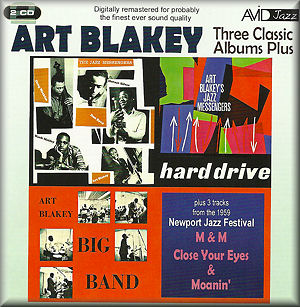CD1
1. Midriff
2. Ain't Life Grand
3. Tippin'
4. Pristine
5. EI Toro Valiente
6. The Kiss of No Return
7. Late Date
8. The Outer World
9. For Minors Only
10. Right Down Front
11. DEO-X
12. Sweet Sakeena
13. For Miles and Miles
14. Krafty
15. Late Spring
CD2
1. Infra-Rae
2. Nica's Dream
3. It's You or No One
4. Ecaroh
5. Carol's Interlude
6. The End of a Love Affair
7. Hank's Symphony
8. Willis Conover's Introductions
9. M & M
10. Close Your Eyes
11. Moanin'
Art Blakey - Drums
Donald Byrd - Trumpet (tracks I/1-8, II/1-7))
Bill Hardman - Trumpet (tracks I/1-15)
Idrees Sulieman, Ray Copeland - Trumpets (tracks I/1-8)
Melba Liston, Frank Rehak, Jimmy Cleveland - Trombones (tracks I/1-8)
Sahib Shihab, Bill Graham - Alto saxes (tracks I/1-8)
John Coltrane - Tenor sax (tracks I/1-8)
Al Cohn - Tenor sax (tracks I/1, 2, 5-8)
Bill Slapin - Baritone sax (tracks I/1-8)
Walter Bishop - Piano (tracks I/1-8)
Wendell Marshall - Bass (tracks I/1-8)
Johnny Griffin - Tenor sax (tracks I/9-15)
Junior Mance - Piano (tracks I/9, 10, 12-15)
Spanky de Brest - Bass (tracks I/9-15)
Sam Dockery - Piano (track I/11)
Hank Mobley - Tenor sax (tracks II/1-7)
Horace Silver - Piano (tracks II/1-7)
Doug Watkins - Bass (tracks II/1-7)
Lee Morgan - Trumpet (tracks II/8-11)
Bobby Timmons - Piano (tracks II/8-11)
Jymie Merritt - Bass (tracks II/8-11)
This compilation contains three LPs from 1956 and 1967, plus some tunes recorded at the Newport Jazz Festival. One tends to associate Art Blakey with small groups - notably the long-running Jazz Messengers - but the first eight tracks come from an album called Art Blakey Big Band. Of course, Blakey had previously played in that hotbed of beboppers, Billy Eckstine's big band in the mid-1940s and he actually led his own big bands for brief periods before and after working for Eckstine.
This big band sounds like an enlarged version of the Jazz Messengers, with Blakey's extrovert drums punching the ensemble along. Blakey's drums are prominent throughout, and his solo on El Toro Valiente takes no prisoners. No arrangers are credited for any of these tracks but there are some respectable solos from the likes of Bill Hardman, Sahib Shihab, Walter Bishop and John Coltrane. In fact tracks 3 and 4 of the first CD are by a quintet of Donald Byrd, John Coltrane and the rhythm section. At this time Coltrane was a fairly typical bebop player, but in his swinging solo on his composition Pristine you may detect inklings of the "sheets of sound" for which he later became famous.
The remainder of the first CD consists of the album Hard Drive by the 1957 line-up of the Jazz Messengers. This takes us into an airier sound world, where the individual musicians are free to relax without the bombast of a large ensemble. The star soloist is Johnny Griffin, whose solos swing easily while showing off his prodigious technique. DEO-X typifies the Jazz Messengers style: set in motion by Blakey's explosive drums leading into the trumpet/tenor sax blend which was the group's hallmark for so long. Junior Mance's sure touch is an integral feature of the rhythm section.
The first seven tracks of the second CD feature the 1956 version of the Jazz Messengers, when Horace Silver was still in the band. His solo on Nica's Dream is outstanding, but then he wrote this attractive tune which has understandably become a jazz standard. Silver also wrote the interestingly-chorded Ecaroh. Hank Mobley wrote three of the seven tracks on this LP, including Hank's Symphony which actually highlights Art Blakey's varied drumming skills. You can't say that Art was backward in coming forward!
The compilation closes with three tracks recorded at the 1959 Newport Jazz Festival. M & M is another Mobley composition, in exactly the kind of bebop mode that suited the Messengers. Close Your Eyes has a simple but effective arranged introduction of the type which made a neat contrast with the group's solos. Lee Morgan goes to town on this one. Pianist Bobby Timmons' tune Moanin' gets a groovy performance with a righteous gospel feel. These three final numbers each last for at least nine minutes, letting the musicians stretch out.
Tony Augarde
